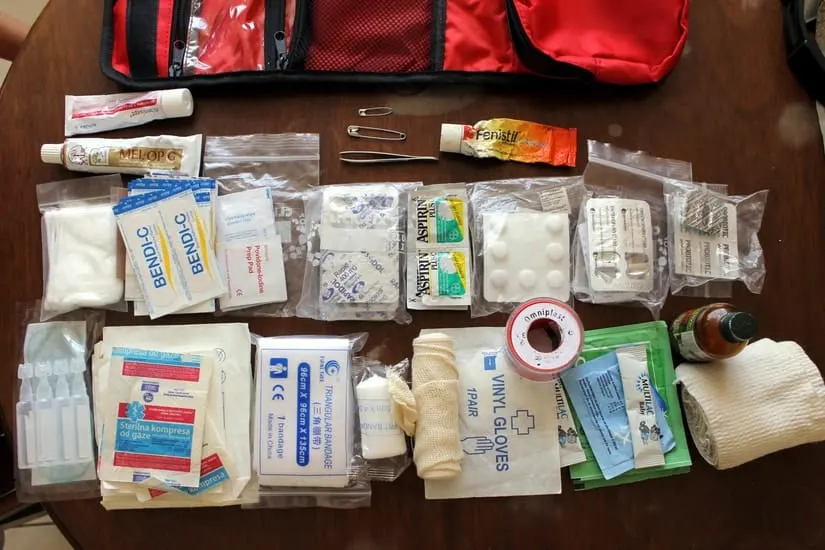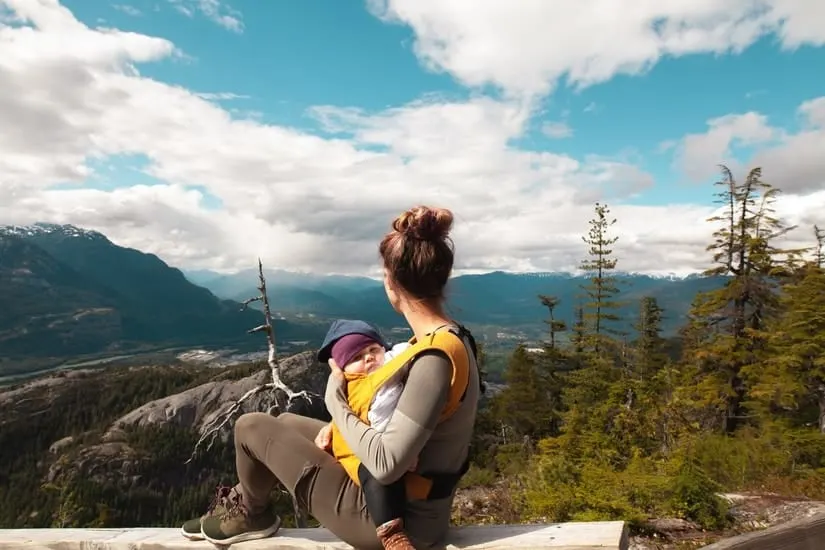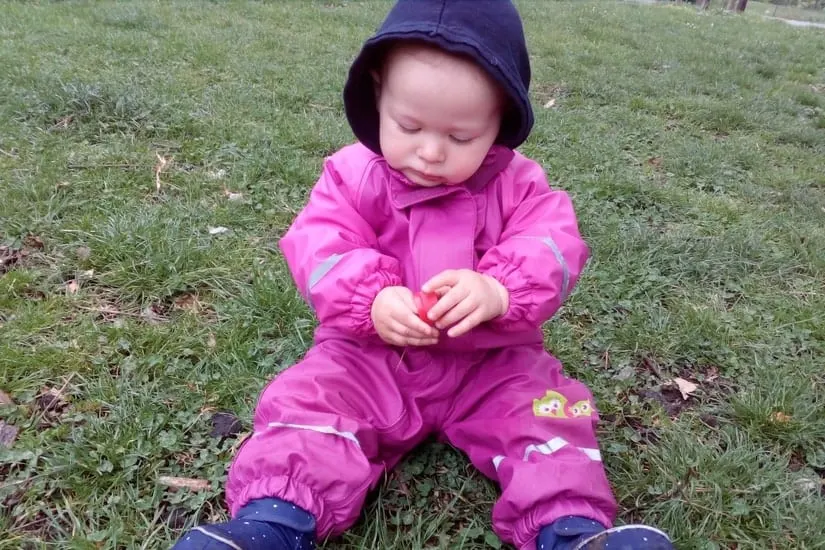SHTFDad may collect a share of sales or other compensation from the links on this page.
Since becoming a father I’ve taken emergency preparedness several steps further.
It’s one thing to be responsible for your own safety. It’s a completely new ballpark when there’s a tiny life depending on you!
As a result, I’ve carefully built a baby emergency kit with essential items that we will need when SHTF.
Building a Baby Emergency Kit: Do It Now!

When you’ve got a baby, your life gets pretty busy (that’s an understatement!). It’s easy to put off building a baby emergency kit until “later.”
My experience is that “later” never actually happens. If you don’t get it all done while you are motivated, you will end up with a half-complete kit that lacks essentials for emergencies like blackouts, natural disasters, or other more serious SHTF scenarios.
Steps to take to ensure your children’s survival kit actually gets built:
- Identify what SHTF disasters you are planning for.
- Take inventory of what you already have and what you need.
- Schedule time for planning and shopping.
- Make a list! Otherwise, you’ll probably forget something important.
- Budget accordingly. Some items can be pricey and you don’t want to skimp on them.
Also, don’t forget to regularly update your emergency kit. As your kids get older, they will have different needs.
Baby Emergency Kit vs. Baby BOB
You will need at least TWO kits. One kit is for hunkering down at home (such as after an earthquake or during a blackout). It should be kept someplace accessible during a disaster, such as in your storm shelter or in a safe room.
The other kit is for when you have to evacuate or bug out. Many people like to keep their bug-out bag near their doorway so they can quickly grab it and flee. You might also want another bug-out bag in your vehicle in the event disaster strikes while you aren’t at home.
Making two (or more) baby emergency kits does mean you’ll have to buy multiple of certain items. If you have to save money, build the baby bug-out bag first.
You can always tap into it while hunkering down but won’t necessarily have time to grab supplies from your home when evacuating.
Baby Emergency Kit List
Here’s a breakdown of key items I’ve included in my baby’s survival kit and bug-out bag.
Note that I realize every family has different needs, so your kit might look different. Hopefully, this list will help you in building your own kit.
1. Water
Infants and babies have a higher amount of water in their bodies, so are more susceptible to dehydration. You’ll need a reliable source of water for them in your baby emergency kit.
Bottled water is the surest way to go for infants. If you are planning for longer-term emergencies, then you’ll need a water treatment method like a way to boil water for purification or water treatment tablets.
2. Food

Even if mom is breastfeeding, you will still want to have formula in your baby’s emergency kit.
This will be necessary in case she gets separated from the baby or injured and is thus unable to breastfeed. Obviously, you’ll also need bottles too.
For babies who are already on solids, I prefer baby food in pouches. You don’t have to worry about it breaking like jars of baby food. It’s much easier to carry in a baby bug-out bag too.
3. Diaper Kit
I use cloth diapers for my child. The problem with cloth diapers for emergency planning is that they need to be cleaned. Hand-washing diapers during a power outage does not seem like fun. Plus, it requires a lot of water, which might not be available if the power is down.
In that case, I have a stockpile of disposable diapers in case of a disaster. If these run out, I will use the cloth diapers.
For infant bug-out bags, diapers are more problematic. While diapers are lightweight, they are also very bulky. You’ll want about 3-days’ worth of disposable diapers in the BOB. Even this amount will take up a lot of room.
I’d recommend putting at least a few cloth diapers and covers in the BOB in case you run out of disposables.
Tip: Get liners for cloth diapers. That way you’d be able to easily throw away the poop, making it much easier to clean the diapers by hand.
In addition to diapers, you will also need:
- Baby wipes – lots of them!
- Barrier cream
- Changing pad – optional but useful when on the go
- Clinically Proven: Pampers Sensitive wipes are...
- Thick and soft: Gently cares for your baby’s...
- Skin-Friendly: Gentle and hypoallergenic—0%...
- Remedy Olivamine Nutrashield Skin Protectant...
- Long lasting nourishing formula that helps prevent...
- Ideal for patients with very dry skin, such as...
- Fully padded for comfortable changes on the go
- Secures closed with Velcro tab
- Protects baby from dirty surfaces
4. Sleep Setup

As someone who’s gone camping with my children many times (my youngest went on his first backpacking trip at 4 months old), I know firsthand about trying to keep babies warm while sleeping outdoors.
I strongly suggest you get a sleeping bag for your baby which is specifically made for outdoor use, such as the one by Morrison Outdoors. You’ll also need a sleeping pad for your baby.
- Basic closed-cell foam sleeping pad is a...
- Trusted by outdoor enthusiasts for generations,...
- Designed with supportive peaks and heat-trapping...
In winter blackout situations, you’ll be happy with a baby sleeping bag. Sleeping bags trap heat much better than blankets, and you don’t have to worry about suffocation risks from heavy blankets.
It is possible to co-sleep with your baby, but this is a pain – especially in wilderness survival scenarios. Imagine trying to keep a fire going throughout the night while bugging out.
Your baby would freeze in an adult-size sleeping bag without your body heat. You’d also wake your baby every time you entered/exited the sleeping bag.
5. Baby First Aid Kit

Do you really know how to act in case of an emergency? In case of an emergency, you need to know the correct way to handle the situation. A medical survival guide to complement your baby’s emergency kit is critical.
An emergency first aid kit for a baby looks pretty similar to a kit you’d pack for adults: lots of antiseptic creams for wounds, bandages, sterile gauze, tweezers, and so forth.
However, there are some extra things you will need for a baby. These include:
- Fever medication: Babies are very susceptible to fevers. I keep liquid baby ibuprofen for fevers in our medicine kit.
- Thermometer: I prefer a standard thermometer over a digital one because it doesn’t require batteries and is more compact.
- Measuring syringe: For liquid medications
- Electrolytes (aka oral rehydration salts): Dehydration can quickly kill infants. Electrolyte packets quickly rehydrate babies.
- Saline drops: These are incredibly useful for clearing clogged noses or flushing dirt out of a baby’s eyes. They can also be used for cleaning wounds.
- Zinc cream: For treating diaper rash. You don’t want your baby screaming all night because of a rash when you’ve got an SHTF situation going on!
- Nasal aspirator: Babies get fussy as hell when their noses are clogged. Make sure to have one of these in your medicine kit.
- ACTIVE INGREDIENT: This pain relief medicine...
- PAIN RELIEVER AND FEVER REDUCER: Temporarily...
- MADE FOR CHILDREN: Amazon Basic Care Children's...
- VALUE PACK: This package contains 100 1mL Syringes...
- SYRINGES ONLY: This package does not come with...
- PET CARE: Makes the process of feeding on nursing...
- FAST, EFFECTIVE REHYDRATION: Pedialyte provides an...
- COMPARED TO OTHER BEVERAGES: Designed to replace...
- FROM THE #1 BRAND: Enjoy great-tasting flavors...
- Unique design can be held downward as a saline...
- Relieves runny, stuffy, dry, or crusty noses
- Flushes and removes mucus from little noses to...
- RECOMMENDED HOSPITAL GRADE SILICONE EAR SYRINGE &...
- REVOLUTIONARY TWISTER DESIGN – Designed in USA....
- TRANSLUCENT BULB - See how much snot is being...
6. Child Carrier

There are all sorts of great child carrier backpacks that are designed for hiking. These are great for evacuation/bugging out too.
In my case, I went with a front carrier. Why? Because if I had to flee somewhere, I’d also be wearing a backpack with gear. None of the baby carrier backpacks have storage pockets large enough to fit all the gear we’d need.
- DESIGN - 4-in-1 carrier with adjustable ergonomic...
- WEARING POSITIONS - Convertible facing-in and...
- BENEFITS & USE - Experience hands-free convenience...
7. Baby Leash
A baby leash is an item you won’t find on most family survival gear lists. However, after talking to many people who’ve spent nights in emergency shelters, I see it as a necessity, especially for a toddler emergency kit.
In emergencies, places can get VERY crowded. It would be easy to lose a walking or even a crawling child. By putting the baby on a leash, the baby would still be able to move around (and thus be a lot less fussy).
Trust me, it’s going to be hard to keep a constant eye on your toddler when you are already exhausted and stressed.
- KEEP YOUR LOVED ONE CLOSE: Reduce the fear and...
- SAFE & COMFORTABLE: Padded straps keep your kid...
- ADJUST THE DISTANCE TO DESIRED LENGTH: The wrist...
8. Waterproof Suit

Evacuating ahead of a hurricane? Being rescued by boat? Bugging out and it starts raining? These are all reasons you should have waterproof suits in your family Go Bag.
*I actually have rain suits for ALL of my family, not just the baby!
- [Customized Fit]: This rain suit kids has...
- [Safe]: Reflective tapes on arms, front and back...
- [Waterproof]: 10,000mm Waterproof rating material....
9. Layered Clothes
Babies have a remarkable ability to get dirty. You’ll want to make sure you’ve got at least 3 changes of clothing for them in your Go Bag. This is ideal so that you have spares to change into while waiting for your clothes to dry.
It’s important that you choose clothes that can be layered. For example:
- A merino wool base layer
- Pants and shirt
- Hoodie or sweater
- Jacket
- Gloves and hat
The layering system will allow you to regulate your baby’s temperature easily as the weather changes. Make sure you choose clothes that are breathable and don’t absorb water. If any layer of the clothes gets wet, it screws up the entire layering system.
Merino wool, fleece, and certain synthetics are all good materials. You can find these quality baby clothes in a lot of outdoor sports stores.
10. Tent

For your family BOB, you should really have a tent. I know that a lot of hardcore survivalists only pack a tarp or plan to make a debris hut in the wild.
However, this really isn’t practical when you’ve got a baby. It’s important that you learn how to waterproof your tent and do so ahead of time.
It takes time to make debris shelters, and babies aren’t exactly going to sit calmly while you gather supplies! As for tarp shelters, I’d rather have a shelter that doesn’t allow creepy crawlies in or allow my baby to crawl out while I sleep.
Note that tents are important in shelters. Even though it’s best to avoid evacuation shelters at all costs, it’s not always possible when you’ve got an infant in tow.
If you do end up in an evacuation shelter, you’ll be happy for a tent to set up. It will give you some privacy in crowded conditions.
Other Items for a Baby Emergency Kit
- Extra hand sanitizer (for after diaper changes)
- Pacifiers
- Comfort items, like a blankie or toy
- Hand warmers
- Ziploc baggies for dirty clothes and cloth diapers
- Burp rags
- Sun hat
- Made without parabens, sulfates, phthalates,...
- Made with plant-derived and other thoughtfully...
- Alcohol-free
- Super soft, Our muslin burp cloths is made of...
- Absorbent, our burp cloths is really absorbent, it...
- Quick dry, the muslin burp cloths is quick dry,...
- 100% polyester and the material is soft
- Diameter(inch): 7.5 inner, 13.5 outer
- UPF 50+ excellent sun protection, Anti-UV and...
Any other items that you would add to the list?

Is your family really prepared for anything?
This leaked report will save your life.
I just finished watching the most eye-opening video ever.
I thought I was prepared but Dan Sullivan proved me wrong.
Click the image below and see for yourself:
P.S. Watch all the way to the end because he’s going to reveal a few blind spots that most preppers have in their survival plans.
Click here to watch the video.
Resources:
















